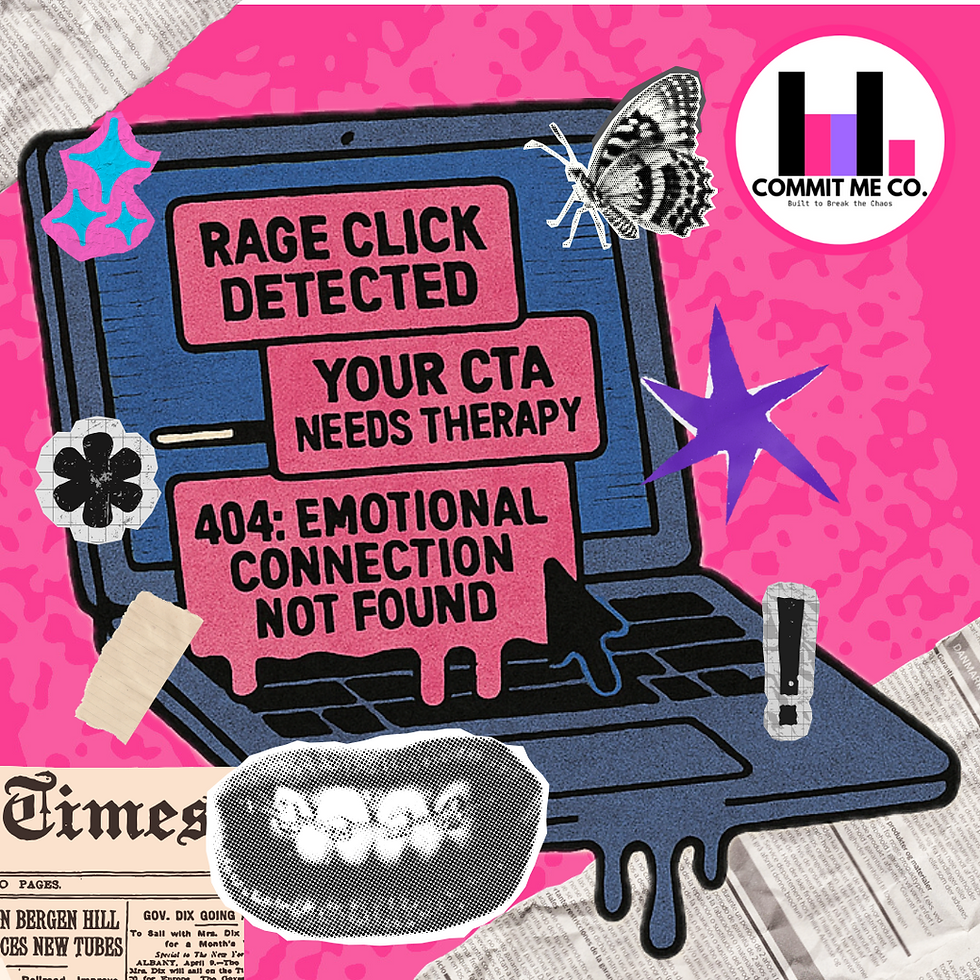Rage Clicks as Rebellion: Why Behavioral UX Matters for Small Businesses
- Emily Neuhoff
- Aug 25
- 8 min read
Every rage-click is a fist in the air. Not a mistake. Not a bug. A protest.
In the chaotic pulse of the digital world, clicks, scrolls, and swipes aren't just interactions-they're signals. And when those signals turn frantic, it's not users "failing." It's your system collapsing under its own broken promises.
At Commit Me Co, we don't bury that chaos under bland metrics. We amplify it. Because behavioral UX is punk: it refuses to smooth the edges or silence the noise. Rage clicks, dead-end journeys, abandoned carts-these aren't faults. They're the loudest truths your users can give you.
The brands that thrive are the ones willing to listen, decode, and rebuild. That's where digital chaos becomes connection-and where small businesses stop chasing algorithms and start creating experiences that actually resonate.
The Myth of User Error

When digital interactions collapse, the blame usually falls on the person behind the screen.
“They didn’t know where to click.” “They don’t understand tech.” Nah. That’s lazy thinking.
The truth? System design misleads. Interfaces gaslight. A button that looks clickable but isn’t. A checkout flow that loops like a broken record. A navigation that feels like a maze with no exit.
Every “mistake” a user makes is actually a signal. Every rage click, every abandoned cart, every confused scroll—it’s data. And when we stop blaming users and start decoding those signals through behavioral UX, we uncover the real story.
The shift is simple but radical: don’t fix the people. Fix the system.
Users Aren't Broken
Users aren’t the problem. They’re just trying to survive in digital landscapes that keep tripping them up. When someone struggles with a site or app, the easy out is to blame their “lack of tech skills.” But that’s just bad design scapegoating.
Think about it: if a door handle doesn’t work, do you blame the person trying to open it? Of course not. You fix the handle. Digital interfaces are no different.
Every user brings their own mental models—the expectations shaped by a lifetime of swiping, scrolling, and tapping. When those expectations collide with a confusing layout or a misleading button, the result is frustration. Not because the user is wrong, but because the system failed to meet them halfway.
That’s where behavioral UX flips the script. It shows us that so-called “errors” are actually logical responses to the environment we’ve created. If the system misleads, the rage click makes perfect sense. The insight is simple: stop blaming people, start decoding behavior, and build designs that actually make sense.
Behavioral UX research shows that users' actions are often logical responses to the environment they're presented with. By understanding these behaviors, we can create more intuitive and user-friendly designs.
System Design Gaslighting
Ever click a button that looked like it should work… and nothing happens? That’s not your fault. That’s system design gaslighting—when an interface tricks you into thinking you messed up, when really the design is broken.
It’s subtle, but brutal. Buttons that look clickable but aren’t. Navigation menus hidden like secrets. Pages where the rules change every time you scroll. These aren’t quirks—they’re failures.
And they don’t just annoy people. They erode trust. Every moment of digital frustration chips away at loyalty until the user finally bails.
At Commit Me Co, we don’t smooth over those cracks—we rip the duct tape off. By calling out design gaslighting for what it is, we can rebuild interfaces that are transparent, honest, and human-centered. Respect the user’s intelligence, and you’ll earn something algorithms can’t buy: trust.
Rage Clicks as Mosh Pits

A rage click isn’t random noise. It’s a stage-dive. A thrash in the pit. A moment where digital chaos gets loud enough to demand attention. Just like a mosh pit at a punk show, it might look like total disorder from the outside. But inside? It’s organized rebellion. People aren’t flailing for nothing—they’re reacting to the energy, the push, the system around them.
Users do the same. When someone hammers a broken button or spirals in a dead-end flow, that’s not stupidity—it’s user behavior in context. It’s the clearest signal your UX design is out of sync with their expectations.
The trick isn’t to silence the pit. It’s to decode it. Rage clicks tell you exactly where friction lives. And once you learn to read that chaos through behavioral UX, you can turn frustration into fuel for better design.
Organized Rebellion
Rage clicks aren’t random tantrums. They’re protests. A coordinated rebellion against a user experience that isn’t holding up its end of the deal. Just like the chaos of a punk rock mosh pit, rage clicks look messy on the surface—but there’s rhythm in that chaos.
When someone hammers a dead button or slams a non-responsive element, it’s not “user error.” It’s digital rebellion. It’s the clearest way a person can scream: “This system isn’t working for me.”
To decode rage clicks, you can’t just stare at surface-level analytics. They’re not noise, they’re expressions of intent and expectation. Behind every rapid click is a story about user behavior, frustration, and broken design patterns.
That’s where Commit Me Co's Digital DNA Test comes in. We translate it that is already being tracked. We turn digital chaos into clarity, exposing the cracks in your system and transforming rage clicks into roadmaps for trust, loyalty, and better design.
Thrashing Against Friction
Friction is the enemy. It’s that invisible wall users hit when a digital product doesn’t flow the way it should. And when people slam into that wall, they don’t just give up quietly—they thrash.
Thrashing looks like chaos:
Clicking the same dead button again and again.
Jumping back and forth between pages like there’s a way out.
Scrolling frantically, hunting for answers that should’ve been obvious.
This isn’t random frustration. It’s the body language of user experience online. And just like in a mosh pit, that energy means something. Every frantic scroll and failed click is a clue.
At Commit Me Co, we see thrashing behavior as more than noise. It’s a roadmap. By decoding where users slam against friction, we expose weak points in design and rebuild with behavioral UX. That’s the punk marketing approach—embrace the chaos, respect the signal, and turn digital rebellion into something smoother, sharper, and more human.
From Noise to Narrative

Most digital analytics dashboards feel like listening to static at full volume—numbers screaming, charts flashing, chaos everywhere. Brands look at it and think: “More data means more clarity.” But in reality, raw data is just noise.
The trick isn’t collecting more. It’s translating the chaos.
That’s what behavioral UX does. It turns rage clicks, drop-offs, and scroll thrashing into something you can actually use: a story. Not just what people are doing, but why. Not just numbers, but motives, expectations, and emotions.
When you start to hear the narrative inside the noise, design stops being guesswork. Suddenly, you know where trust cracks, where flow collapses, and where your audience actually wants to connect.
Analytics as Mixtapes
Most brands treat analytics like a spreadsheet graveyard—dry stats with no pulse. But data doesn’t have to be lifeless. Think of it like a mixtape.
A good mixtape isn’t just a pile of songs. It’s curated. It’s sequenced. It tells a story through rhythm, contrast, and flow. User data works the same way.
When you curate the right metrics, arrange patterns, and layer in context, the noise of digital chaos becomes a narrative. Rage clicks become verses. Drop-offs become bridges.
Conversions? That’s the hook. Suddenly, you’re not just crunching numbers—you’re listening to the soundtrack of your users’ journey.
Humanizing Behavioral Data
Behavioral data isn’t just numbers. It’s people. Every scroll, every rage click, every bounce tells a story about real human frustration, curiosity, or desire. If you only see stats, you miss the heartbeat behind them.
Humanizing data means shifting from what happened to why. It’s about turning charts into faces and metrics into voices. Techniques? Think less “dashboards” and more “diaries”:
Build personas out of actual behavioral patterns, not marketing guesses.
Map emotional journeys through user flows—the highs, the breakdowns, the exits.
Layer in qualitative context so numbers don’t flatten out real experience.
This is the soul of behavioral UX: designing not just for clicks, but for connection. When you analyze through a human lens, your digital products stop being sterile and start resonating.
Because at the end of the day, users don’t remember frictionless interfaces—they remember when a system felt like it got them.
The Punk Marketing Rebellion

It’s what happens when you finally torch the cookie-cutter playbooks and stop designing for algorithms instead of people. Conventional strategy says: polish the numbers, hide the cracks, chase trends until you disappear in the noise. Punk says: make it raw, make it real, make it human.
Through behavioral UX, we don’t just track clicks — we translate chaos into clarity. Rage clicks, thrashing, drop-offs: all of it becomes fuel for design that actually resonates.
Anti-Top 40 Strategies
Top 40 hits are safe. Predictable. Overplayed. And most digital marketing strategies sound the same way—cookie-cutter campaigns that fade into static.
Anti-Top 40 marketing is the rebellion. It ditches the mainstream, one-size-fits-all formulas and builds something raw, specific, and alive.
Here’s what that looks like:
Authenticity over polish. Stop sanding down the edges—people connect with the rough cuts.
User needs over industry trends. Forget the hype cycles. Listen to what your audience actually wants.
Creative risks over copy-paste campaigns. Play weird. Experiment. Push until something breaks—and then rebuild it better.
This isn’t just marketing—it’s the punk ethos applied to design and strategy. By rejecting the Top 40 playbook, your brand stands out in a crowded feed and delivers authentic experiences that resonate.
For inspiration on Anti-Top 40 marketing strategies, check out our Instagram posts showcasing unconventional approaches to digital marketing.
Resisting One-Size-Fits-All
One-size-fits-all is a lie. In user experience design, it’s the bland Top 40 hit that nobody actually asked for. Real people don’t move through digital spaces the same way—and pretending they do is how frustration, rage clicks, and drop-offs multiply.
Resisting that mindset means embracing the mess of human behavior. It means building for diversity, not averages. How?
Segment by behavior. Use behavioral data to spot real patterns, not assumptions.
Craft personalized journeys. Meet users where they are, not where the industry says they “should” be.
Test, thrash, repeat. Keep iterating until friction fades and flow feels natural.
Rejecting generic solutions isn’t just punk—it’s practical. Digital experiences that feel tailored and relevant build loyalty, cut friction, and convert better.
At Commit Me Co, that’s exactly what the Digital DNA Test™ delivers: a clear map of your users’ unique signals, so you can design experiences that actually connect.
Learn more about how to implement these strategies in your business by exploring our Digital DNA Test, which helps identify unique patterns in your users' behavior.
Conclusion

Chaos as Feedback Channel
Digital chaos isn’t failure—it’s feedback. Rage clicks, abandoned carts, frantic scrolls—they’re not flaws in your users, they’re screams from your system. And if you listen close, you’ll hear the truth: every glitch is a map. Every drop-off is a clue. Every act of digital rebellion is a chance to rebuild better.
When you embrace the chaos, you unlock what the mainstream misses:
Pain points that kill flow
Unexpected behaviors that reveal new paths
Opportunities to innovate instead of imitate
That’s the punk ethos of UX and SEO—don’t polish over the cracks, amplify them.
Amplify with Digital DNA Test
🖤 At Commit Me Co, our Digital DNA Test™ is built for exactly this. We decode your users’ loudest signals and turn them into actionable insights:
Expose friction before it breaks trust
Translate rage clicks into design fixes
Transform raw data into strategies that actually resonate




Comments